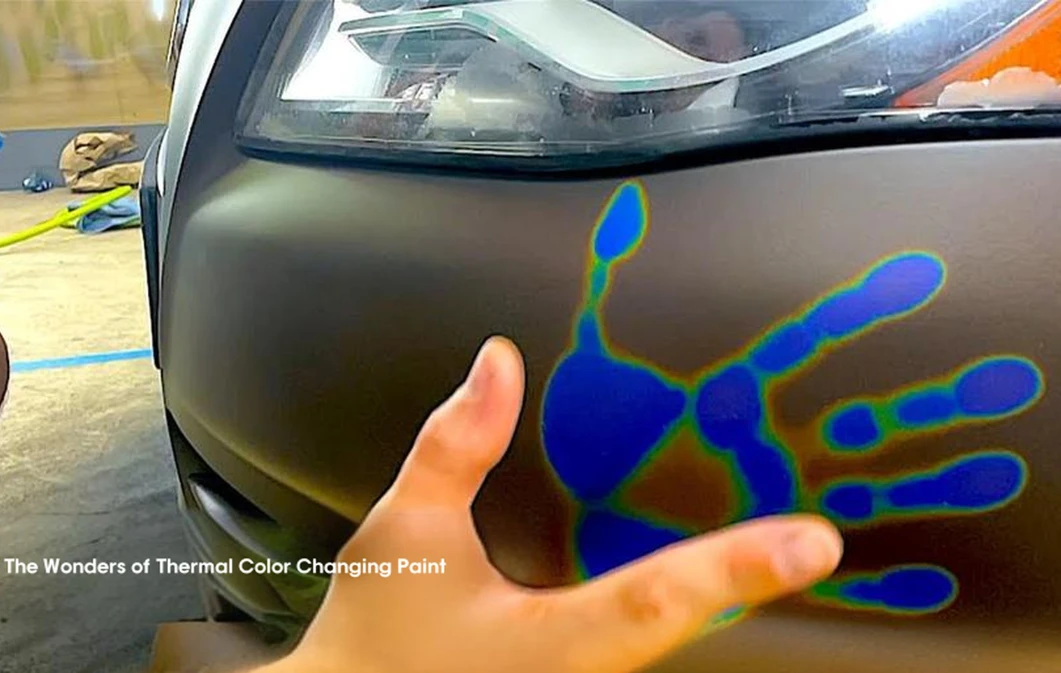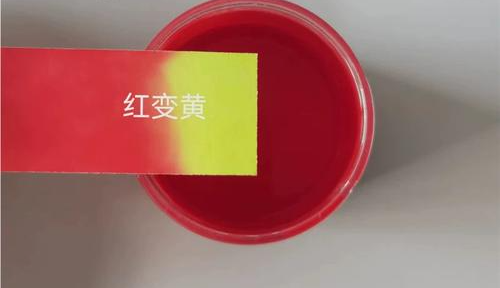1. Problems When We Process Themochromic Pigment.
Q1: What are the temperature requirements for thermochromic powders when processing?
Description: We need to process thermochromic powders before preparing thermal products. What are the temperature requirements for thermochromic powders during processing? What is the most suitable temperature for processing thermochromic powders?
Answer: The temperature for processing thermochromic powders should be below 200℃ and should not exceed 230℃. Besides, we should reduce the time for heating material. (High temperature and long-time heating will damage the color-changing property of pigment).
Q2: Can I mix different colors of thermochromic powders?
Description: I designed a product based on temperature-sensitive material. It can change different colors as the temperature changes. However, the thermochromic powder with different working temperatures is required to realize such colorful effect. Can we mix them together?
Answer: Reversible thermochromic powders are colorless in invisible state. Therefore, we can match color-changing pigments with different colors/color-changing temperatures/series. In this way, we can obtain more color-changing effects. If we mix basic colors at a certain ratio, we can obtain many intermediate colors and colorless effects.
2. Problems When We Use Themochromic Pigment in Different Applications.
Q1: Can thermochromic temperature activated pigment be used on the ceramic cup?
Description: I am a mug creative factory, a customer needs to print photos on the cup and then touch it to display it? How do I achieve this effect?
Answer: Use the Kingchroma series of black thermochromic temperature activated pigment powder, spray it on the cup. Or use black thermotropic vermicelli to print on the film. The pattern is transferred to the ceramic cup by thermal transfer.
Both of these ways can make the cup achieve the effect you want.
Q2: How many degrees of thermochromic pigment powder is usually appropriate for thermochromic clothes?
Description:Recently, temperature-sensitive and color-changing clothes are best sellers in clothing industry. They become fashion clothes for young people. When the manufacturer is making temperature-sensitive and color-changing clothes, what is the most suitable thermochromic pigment powder?
Answer: It is recommended that thermochromic pigment powder with working temperature of 20-33℃ is the most suitable for making temperature-sensitive and color-changing clothes. This is because human body temperature is about 37℃. Kingchroma thermochromic pigment powder can effectively show the pattern after temperature change.
We recommend the thermochromic pigment powder made by Kingchroma for making temperature-sensitive and color-changing clothes. Kingchroma thermochromic pigment powder has passed EN-71 and ROHS tests. It does not contain any matters that are harmful to human health. At the same time, it accords with the packing specifications for safe toys and food. It is a good choice for making color-changing clothes.
Q3: How can thermochromic powders be used in anti-counterfeiting technology?
Description: I need to make a batch of anti-counterfeit materials whose color changes with temperature. Can I use the thermochromic powder? Is there any case of application in anti-counterfeit technology?
Answer: Anti-counterfeit technology is a unique function of thermochromic powder. Such anti-counterfeit technology is based on the color-changing requirement of the thermochromic powder. Thermochromic powder can quickly change its color with the change of ambient temperature, bringing a dynamic color effect on the colored object.
Q4: Thermochromic dye powder to adjust the water-based pulp printing cloth what are the common problems?
Description: Many customers use thermochromic dye powder to prepare water-based paste printing cloth. However many customers encounter different problems during the use of thermal powder. Today we will analyze it.
Answer: I. If we use thermochromic dye powder to prepare water-based paste printing cloth at 33℃, we should put two bolts of cloth in an air-conditioned room, so that it will present the desired color.
Possible causes
- Thermochromic powder is exposed to sunlight or UV lamp light, causing poor effect of color change;
- The microcapsule loses efficacy at high temperature, resulting in poor effect of color change. In such cases, the effect cannot be recovered.
II. After the use of the thermal paste and thermochromic powder, the thermal paste becomes rough after it is printed by 150 mesh. When we add thermochromic powder to the paste, the ratio of color change is around 8% and there are some residues.
Solutions: Make the mesh smaller and use 180 mesh, and change the added proportion of thermochromic powder as 6%.
Q5: What is the additive ratio of thermochromic pigment powder for thermochromic printing ink?
Description: Thermochromic pigment powder has the function of repeated color change. Therefore, it is also widely used in clothing screen printing. Do you know the mixing ratio of the thermal powder when it is used for screen printing? Today, we will tell you the mixing ratio of the thermochromic pigment powder to printing ink.
Answer: Temperature-sensitive and color-changing screen printing is a typical example of invisible screen printing. For temperature-sensitive and color-changing screen printing, thermochromic pigment powder enables the color of pattern to change with temperature. Substances whose color changes with temperature include inorganic substances and organic substances. Most temperature-sensitive and color-changing substances used for textile products are organic substances.
Kingchroma thermochromic pigment powder contains microsapsule color-changing particle with a size of 1-10um. It is resistant to high temperature and oxidation. Therefore, the adding proportion of thermochromic pigment powder for preparing thermal paste is 3%-12%. If an ordinary pigment and a color-changing pigment are required for color matching, the dose of ordinary pigment (or dye) should account for about 0.5%-2.5% of the amount of color-changing pigment.
Q6: What do I need to pay attention to when using temperature change powder in injection molding?
Description: I am a mobile phone shell manufacturer. Recently, we developed a color-changing mobile phone shell. It is able to sense the change in ambient environment and produce the effect of color change. The principle is that we add temperature change powder during the production of mobile phone shell, and thus we can produce the mobile phone shell with the effect of color change. We encountered some problems during the machining process of mobile phone shell, one of which is injection molding. What issues should be addressed in terms of the injection molding of the temperature changing powder?
Answer: We should pay attention to the following matters:
- Processing temperature for injection molding of temperature change powder: Processing temperature is one of the factors that affect the effect of the temperature change powder.
- When we use color-changing pigments for injection molding and extrusion, we should not add other packing materials or ordinary pigments (such as titanium dioxide, calcium carbonate, barium sulfate, and carbon black) to the plastic. Otherwise, they may influence the using effect of temperature change powder and hide its color-changing effect.
- Select cross-linking agent or curing agent carefully: During the cross-linking and curing of epoxy resin and unsaturated polyester resin, a great shrinkage stress may sometimes produce inside them, causing the shell of temperature changing powder microcapsule to break. As a result, other chemical substances will go into the pigment, causing it to lose color-changing property. This is often the case when the curing thickness of epoxy resin is more than 0.2mm and polyamine curing agent is used.
Q7: When using thermochromic pigment for screen printing, What should we be mindful of?
Description: Thermochromic pigment product is a type of microcapsule composed of an organic coloring system with a special chemical structure. The particles of this pigment are spherical in shape, with an average diameter of 2-10 micrometers (one micrometer is equivalent to one-thousandth of a millimeter). The inside is a substance that causes discoloration, and the outside is a clear shell that is around 0.2-0.5 microns thick and cannot dissolve or melt. It is this shell that protects the discoloring substance from the erosion of other chemicals. To protect the discoloring substances inside, what should we keep in mind while performing screen printing with thermal powder?
Answer: The following are some tips to keep in mind when doing screen printing with thermochromic pigment:
1. Preparation of printed items: Make sure the surface of printed items is clean, flat, and free of grease or other dirt. You can wipe the surface with cleaning agents or alcohol to guarantee the powder adheres firmly.
2. Selection of screen: Choose an appropriate mesh screen that matches the thermal powder’s size to achieve the desired printing effect. (It is recommended to choose 120-180 mesh)
3. Tension of screen: Make sure the screen tension is right. Incorrect tension, whether too high or too low, can impact the quality of screen printing.
4. Temperature control: The thermal powder is sensitive to temperature, so it’s crucial to control the temperature of the screen printing machine. High or low temperatures can cause temperature changes that are not satisfactory. We should regulate the temperature based on the properties and specific needs of the thermal powder.
5. Pressure control: During screen printing, use enough pressure on the screen to print powder evenly.
6. Printing speed: Manage the printer speed carefully, to guarantee smooth printing of thermal powder and avoid undesirable outcomes resulting from excessive acceleration or deceleration.
7. Cleaning screen: Clean the screen immediately after printing to avoid thermal powder clogging the screen holes.
8. Quality monitoring: Regularly monitor quality and analyze samples to make sure that printing results are stable and consistent.
The above are some key points to pay attention to during the screen printing operation of thermochromic pigment powder. Depending on the specific requirements of thermal powder products and screen printing machines, you also need to refer to their specific operating instructions and technical requirements.
KingChroma is a professional thermochromic pigment manufacturers and thermochromic pigment suppliers. We can meet your project’s needs. Please contact us if you need it([email protected]).
3. Problems When We Use Reversible thermochromic pigment.
Q1:How many times does the reversible thermochromic powder cycle to change color?
Description: Reversible thermochromic materials can change color repeatedly as temperature changes. Can they change color for unlimited times? Is there a limit?
Answer: We can take a few quantities of reversible thermochromic powder to be tested in the laboratory, stir it evenly with 504 epoxy glue, and strike off a sample (with a thickness of 0.05-0.08mm) on a piece of white paper. Keep it still above 20℃ for one day. Cut a piece of paper sample with a size of 10×30 mm. Take two beakers with a volume of 600 mL and pour water into them. The water temperature shall be 5-20℃ above the upper limit (T1) of the temperature change range of the sample and no less than 5℃ below the lower limit (T0) respectively (for kingchroma ink, the water temperature shall be set as T0=35℃ and T1=70℃). Keep the water temperature unchanged. Immerse the test sample in two beakers by turns. The duration of each cycle is 3-4 s. Observe the color change and record the number of cycles of reversible color change.
Test shows that the number of color-changing cycles of temperature-sensitive and color-changing pigments is 2,000-4,000 times.
Q2: How to differentiate between reversible and non reversible thermochromic pigments?
Description: Thermochromic pigments are divided into reversible thermochromic ppigment and irreversible thermal powder. Reversible thermochromic pigment can recover the original color, while irreversible thermal powder cannot. Are there any methods for distinguishing them?
Answer:The method for distinguishing reversible thermochromic pigment from irreversible thermochromic pigment is very easy. Reversible thermochromic pigment has a bright color and can change from one color to no color or from no color to one color. Reversible temperature-sensitive and color-changing material is an unstable system (it is difficult for a stable substance to change). Therefore, its light resistance, heat resistance and aging resistance pale in comparison with ordinary pigments. We should pay attention to this during use.
4. Safty and Store Problems When We Use thermochromic pigment.
Q1: Is thermal pigment powder harmful to people? How to use it safely?
Description: Thermal pigment powder is mainly composed of temperature-sensitive chemical substances. It is widely used in products with direct contact with humans, including toys, cards, and medical products. Will it cause harm to human health?
Answer: The towel color will fade when it senses temperature change. The area with a certain color will become colorless. As reported in the news, the towel color fades at high temperatures. Therefore, when we buy thermal towels, we don’t need to worry that the thermochromic pigment powder will fade.
The basic temperature of KingChroma thermochromic pigment powder includes: 18℃, 22℃, 31℃, 33℃, 38℃, and 45℃ (you can choose any temperature within the range of 5-65℃). The customer may choose different colors and temperatures as required. The design of thermal products is based on the color change between high-temperature environment and low-temperature environment. Most of these products are sensitive to body temperature. This property may also be used for security design.
Q2: How to properly store thermal color changing powder?
Description: Thermal color changing powder is an unstable system (difficult for a stable matter to change), and its light resistance and heat resistance are not a patch on ordinary pigments. What issues should be paid attention to when storing thermal color changing powder?
Answer: We should preserve thermal color changing powder in a cool, dry and dark place, and avoid exposure to strong sunlight and UV lamp light. Thermal color changing powder has different thermal stability when it is in chromatic state and achromatic state. The thermal stability of thermal powder in chromatic state is higher than that in achromatic state. Therefore, we should preserve thermal color changing powder with color-changing effect at low temperature in a refrigerator. Under above conditions, the performance of most types of color-change pigments will not deteriorate significantly after storage for 5 years. We should avoid use of it above 75℃ for a long time.
Thermal color changing powder is a kind of nonflammable material. It will not ignite spontaneously even when it is heated to 170℃ in the air. Since it is composed of very fine particles, once it forms dust in the air and the density reaches a certain level, it may cause detonation when exposed to open flame. Please handle it carefully.
5. Other Problems about thermochromic pigment
Q1: Why does thermochromic pigment powder lose its color?
Description: Thermochromic pigment powder printing material is a special kind of printing material. It can change color as the temperature changes, which is so amazing. Some manufacturers print thermochromic pigment powder on towels, but the color will fade. What is the reason? How to deal with such problems?
Answer: The towel color will fade when it senses temperature change. The area with a certain color will become colorless. As reported in the news, the towel color fades at high temperatures. Therefore, when we buy thermal towels, we don’t need to worry that the thermochromic pigment powder will fade.
The basic temperature of KingChroma thermochromic pigment powder includes: 18℃, 22℃, 31℃, 33℃, 38℃, and 45℃ (you can choose any temperature within the range of 5-65℃). The customer may choose different colors and temperatures as required. The design of thermal products is based on the color change between high-temperature environment and low-temperature environment. Most of these products are sensitive to body temperature. This property may also be used for security design.
Q2: How to judge the service life of thermochromic dust?
Description: When we buy thermochromic dust and temperature-sensitive products, we cannot judge the service life of temperature-sensitive and color-changing products although the effect of color change is good. How to solve this problem?
Answer: We can take a few quantities of thermochromic dust to be tested in the laboratory, stir it evenly with 504 epoxy glue, and strike off a sample (with a thickness of 0.05-0.08mm) on a piece of white paper. Keep it still above 20℃ for one day. Cut a piece of paper sample with a size of 10×30 mm. Take two beakers with a volume of 600 mL and pour water into them. The water temperature shall be 5-20℃ above the upper limit (T1) of the temperature change range of the sample and no less than 5℃ below the lower limit (T0) respectively (for KingChroma thermochromic dust, the water temperature shall be set as T0=35℃ and T1=70℃). Keep the water temperature unchanged. Immerse the test sample in two beakers by turns. The duration of each cycle is 3-4 s. Observe the color change and record the number of cycles of reversible color change.
Q3: How to choose thermochromic powder pigment?
Description: There are a lot of thermochromic powder pigment manufacturers and various products on the market. How should I choose appropriate thermochromic powder pigment?
Answer: Bachelor’s Degree in Materials Science and Engineering, Hubei University of Technology
We need to take into account the following aspects when we choose thermochromic powder pigment:
1. Temperature range: The temperature range of thermochromic powder pigment may vary with the type of thermal powder. We need to choose it according to the specific temperature range measured.
2. Color selection: The color of the thermochromic powder pigment should correspond well to the test temperature. If the color is not obvious, it may affect the accuracy of test result. Therefore, we need to choose a thermochromic powder pigment with obvious color.
3. Environmental adaptability: Different types of thermochromic powder pigment can be used in different environments such as high humidity or low temperature. We should make a choice according to the actual environmental condition.
4. Stability: Thermochromic powder pigment should have high stability to ensure the accuracy of test result.
5. Applicable scenarios: Different types of thermochromic powder pigment are applicable to different scenarios such as medical industry, cooking or scientific research. We should make proper choice in light of the actual application scenario.
In conclusion, we should choose thermochromic powder pigment according to the specific demand and actual condition, taking above factors into overall consideration before making a decision.
Q4: What is the best temperature to choose for thermal color changing powder?
Description: The thermal color changing powder will change color with the temperature change, but if the temperature is too low or too high, it will damage the thermal color changing powder, what is the suitable temperature for it to work?
Answer: The good processing temperature of thermal color changing powder is 160-180 degrees, and the dispersing agent can be added when the thermal color changing powder is not dispersed during injection molding. Commonly used temperatures are: 15/18/22/28/31/33/45℃. The optimum temperature for thermochromic temperature activated pigment powders depends on the specific application and requirements. Generally speaking, the design temperature of temperature change powder should be determined according to the usage environment and the desired color change effect. Some thermal color changing powders are capable of color change at near room temperature, while others require higher temperatures to trigger the color change effect. It is recommended that the most appropriate temperature range be selected based on the technical specifications of the thermochromic powder and the manufacturer’s recommendations.
Table of Contents






